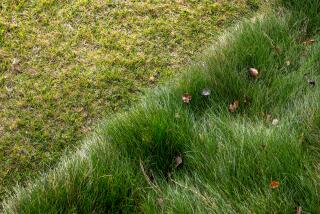Fall Is the Perfect Season for Fescue Sod
- Share via
First of Two Parts
Question: I would like to replace my old bluegrass lawn with a tall fescue from sod. Is now a good time? How do I prepare the soil? What should I look for in high quality sod? V.C., Laguna Hills
Answer: Tall fescue is a cool-season grass, and fall is the time to get it established. There are several things to do before you can install your new lawn.
Soil Preparation
* Apply an herbicide to kill the old grass and any weeds such as Bermuda that might have invaded it. Consult a California Certified Nursery Professional for specific products and follow label directions closely. Hard-to-kill weeds such as Bermuda grass may require repeat applications.
* Measure lawn area. This will enable you to determine how much sod and amendments you will need.
* Ensure that your irrigation system is functioning appropriately and that drainage is adequate. If you don’t have an underground sprinkler system and wish to put one in, wait until after tilling in amendments and fertilizers to avoid pipe breakage.
* Amend the soil. Most of us aren’t fortunate enough to have rich loam soil, so the addition of organic amendments will probably be necessary.
Whichever organic matter you choose, such as rotted manure, compost, ground bark or a mixture, it should be thoroughly decomposed. Fresh organic matter can leach nitrogen from the soil as it breaks down, causing yellowing and slow growth.
Add enough organic matter to change the structure of the soil to a depth of 6 to 8 inches.
* Apply a starter fertilizer, which has a high phosphorus ratio, such as 5-10-5. (The second number represents phosphorous.) Follow the application rates on the bag. Before adding fertilizer, you may wish to have a soil test done to determine whether any specific nutrients are lacking.
* Rototill in amendments and fertilizer.
If you do any extensive regrading, be sure to remove the topsoil and set it aside so it won’t be buried under the subsoil. Once you’re finished grading, spread the topsoil out again. Allow the lawn area to settle for one to two weeks before sodding.
* Level the ground just before planting. This is known as the final grading. Use a water-filled roller (half or less than half full of water) that can be rented at an equipment supply store or nursery.
This will help to improve the soil’s contact with the sod, and it will help lower the soil line so that when installed, the sod will lie flush with sidewalks, driveways, etc.
* Water the sod a day or so before installation. Don’t water the same day and lay the sod on muddy soil.
Sod Selection
* Select sod and arrange for delivery. Purchase your sod from a reputable nursery or directly from a sod grower. Some varieties of tall fescue to consider:
Murietta, Shenandoah, Silverado, Monarch, Aztek, Guardian, Wrangler, Bar None, Crossfire, Amigo, Trail Blazer, Cimmaron, Phoenix, Maverick, Rebel 2, Thoroughbred, Adventure, Apache, Bonanza, Jaguar, Olympic and Mustang.
All of these types are tall fescue, with a variety of minor variations that can be explained to you by the salesperson.
* Plan to install sod the same day it arrives. Upon delivery, inspect it closely. Sod usually comes in 6- to 9-foot rolls or strips that are 2 feet wide. Make sure it has been stored in the shade or under shade cloth.
Unroll a few pieces. It should be moist--never dry--and tear easily. Make sure that the sod is thick from one end to the other and that the edges are cut cleanly.
High-quality sod should be uniformly green. Reject sod that has poor color, yellow spots, weeds or mildew. Place sod in a cool shaded area during installation.
Have a problem in your yard? University of California Cooperative Extension (UCCE) Master Gardeners are here to help. These trained and certified horticultural volunteers are dedicated to extending research-based, scientifically accurate information to the public about home horticulture and pest management. They are involved with a variety of outreach programs, including the UCCE Master Garden hotline, which provides answers to specific questions. You can reach the hotline at (714) 708-1646 or send e-mail to ucmastergardeners @yahoo.com. Calls and e-mail are picked up daily and are generally returned within two to three days.





